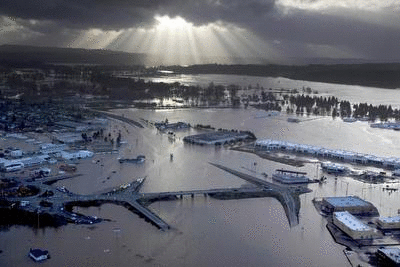 Clean up is well under way after storms wreaked havoc on Oregon’s northwest coast early last month, but businesses will likely feel the effects for quite some time.
Clean up is well under way after storms wreaked havoc on Oregon’s northwest coast early last month, but businesses will likely feel the effects for quite some time.
 STATEWIDE Clean up is well under way after storms wreaked havoc on Oregon’s northwest coast early last month, but businesses will likely feel the effects for quite some time.
STATEWIDE Clean up is well under way after storms wreaked havoc on Oregon’s northwest coast early last month, but businesses will likely feel the effects for quite some time.
Overall, Clatsop, Tillamook and Columbia counties, which took the brunt of the storms, have reported more than $144 million in damages.
Preliminary estimates from the Oregon Department of Transportation put damage to the state’s highway system at around $10 million. Though ODOT was able to quickly reopen many roads from the coast inland, a 20-mile section of I-5 — the West Coast’s main artery — remained closed for three days. A slide that closed Highway 30 for several days did not have a big impact.
Washington State secretary of transportation Paula Hammond estimated that the closure of I-5 resulted in $4 million per day in additional shipping costs. Some, like Bob Russell, president of the Oregon Trucking Associations, believe the toll was even higher.
“Ten thousand trucks per day travel along that corridor,” he says. “That’s a lot of cargo.”
Tillamook Bay Railroad, a conveyor belt for timber heading from the coast to the Willamette Valley, also took a major hit. The $20 million in damages to tracks will force an already ailing timber industry, which saw 7,000 acres of trees on private forestland mowed down by the storm in Clatsop County alone, to ship product by truck at additional cost until repairs are made, says Ray Wilkeson, legislative director for the Oregon Forest Industries Council.
Other businesses in Tillamook County avoided floodwaters thanks to Federal Emergency Management Agency dollars that allowed them to elevate after the 1996 floods, says Sheriff Todd Anderson.
Still, many shops throughout the affected areas were forced to close when power lines went down. At the peak of the storm, as many as 66,000 customers were in the dark, says Jan Mitchell, a spokesperson for Pacific Power.
Gov. Ted Kulongoski declared an “abnormal disruption of the marketplace,” as allowed under the state’s new price-gouging law, in areas affected by the storm.
The declaration prevents merchants from increasing prices of essential goods and services — including food, water, petroleum and repair materials and services — by 15% or more during a crisis.
JAMIE HARTFORD
Have an opinion? E-mail [email protected]

